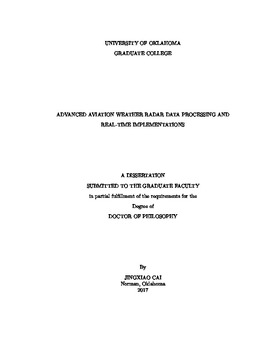| dc.contributor.advisor | Zhang, Yan | |
| dc.contributor.author | Cai, Jingxiao | |
| dc.date.accessioned | 2017-12-11T15:14:10Z | |
| dc.date.available | 2017-12-11T15:14:10Z | |
| dc.date.issued | 2017-12 | |
| dc.identifier.uri | https://hdl.handle.net/11244/52752 | |
| dc.description.abstract | The objectives of this dissertation work are developing an enhanced intelligent radar signal and data processing framework for aviation hazard detection, classification and monitoring, and real-time implementation on massive parallel platforms. Variety of radar sensor platforms are used to prove the concept including airborne precipitation radar and different ground weather radars.
As a focused example of the proposed approach, this research applies evolutionary machine learning technology to turbulence level classification for civil aviation. An artificial neural network (ANN) machine learning approach based on radar observation is developed for classifying the cubed root of the Eddy Dissipation Rate (EDR), a widely-accepted measure of turbulence intensity. The approach is validated using typhoon weather data collected by Hong Kong Observatory’s (HKO) Terminal Doppler Weather Radar (TDWR) located near Hong Kong International Airport (HKIA) and comparing HKO-TDWR EDR$^{1/3}$ detections and predictions with in situ EDR$^{1/3}$ measured by commercial aircrafts. The testing results verified that machine learning approach performs reasonably well for both detecting and predicting tasks.
As the preliminary step to explore the possibility of acceleration by integrating General Purpose Graphic Processing Unit (GPGPU), this research introduces a practical approach to implement real-time processing algorithms for general surveillance radar based on NVIDIA graphical processing units (GPUs). The pulse compression algorithms are implemented using compute unified device architecture (CUDA) libraries such as CUDA basic linear algebra subroutines and CUDA fast Fourier transform library, which are adopted from open source libraries and optimized for the NVIDIA GPUs. For more advanced, adaptive processing algorithms such as adaptive pulse compression, customized kernel optimization is investigated. A statistical optimization approach is developed for this purpose without needing much knowledge of the physical configurations of the kernels. It was found that the kernel optimization approach can significantly improve the performance. Benchmark performance is compared with the CPU performance in terms of processing accelerations. The proposed implementation framework can be used in various radar systems including ground-based phased array radar, airborne sense and avoid radar, and aerospace surveillance radar. After the investigation of the GPGPU on radar signal processing chain, the benchmark of applying machine learning approach on embedded GPU platform was performed. According to the performance, real-time requirement of the machine learning method of turbulence detection developed in this research could be met as well as Size, Weight and Power (SWaP) restrictions on embedded GPGPU platforms. | en_US |
| dc.language | en_US | en_US |
| dc.subject | Engineering, Electronics and Electrical. | en_US |
| dc.title | Advanced Aviation Weather Radar Data Processing and Real-Time Implementations | en_US |
| dc.contributor.committeeMember | Barnes, Ronald | |
| dc.contributor.committeeMember | Cheong, BoonLeng | |
| dc.contributor.committeeMember | Kim, Changwook | |
| dc.contributor.committeeMember | Yu, Tian-You | |
| dc.date.manuscript | 2017-12 | |
| dc.thesis.degree | Ph.D. | en_US |
| ou.group | College of Engineering::School of Electrical and Computer Engineering | en_US |
| shareok.nativefileaccess | restricted | en_US |
